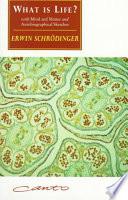Quotes from book
What Is Life?

What Is Life? The Physical Aspect of the Living Cell is a 1944 science book written for the lay reader by physicist Erwin Schrödinger. The book was based on a course of public lectures delivered by Schrödinger in February 1943, under the auspices of the Dublin Institute for Advanced Studies where he was Director of Theoretical Physics, at Trinity College, Dublin. The lectures attracted an audience of about 400, who were warned "that the subject-matter was a difficult one and that the lectures could not be termed popular, even though the physicist’s most dreaded weapon, mathematical deduction, would hardly be utilized." Schrödinger's lecture focused on one important question: "how can the events in space and time which take place within the spatial boundary of a living organism be accounted for by physics and chemistry?"In the book, Schrödinger introduced the idea of an "aperiodic crystal" that contained genetic information in its configuration of covalent chemical bonds. In the 1950s, this idea stimulated enthusiasm for discovering the genetic molecule. Although the existence of some form of hereditary information had been hypothesized since 1869, its role in reproduction and its helical shape were still unknown at the time of Schrödinger's lecture. In retrospect, Schrödinger's aperiodic crystal can be viewed as a well-reasoned theoretical prediction of what biologists should have been looking for during their search for genetic material. Both James D. Watson, and Francis Crick, who jointly proposed the double helix structure of DNA based on X-ray diffraction experiments by Rosalind Franklin, credited Schrödinger's book with presenting an early theoretical description of how the storage of genetic information would work, and each independently acknowledged the book as a source of inspiration for their initial researches.

What Is Life? (1944)
Context: In physics we have dealt hitherto only with periodic crystals. To a humble physicist's mind, these are very interesting and complicated objects; they constitute one of the most fascinating and complex material structures by which inanimate nature puzzles his wits. Yet, compared with the aperiodic crystal, they are rather plain and dull. The difference in structure is of the same kind as that between an ordinary wallpaper in which the same pattern is repeated again and again in regular periodicity and a masterpiece of embroidery, say a Raphael tapestry, which shows no dull repetition, but an elaborate, coherent, meaningful design traced by the great master.

“PHYSICAL LAWS REST ON ATOMIC STATISTICS AND ARE THEREFORE ONLY APPROXIMATE”
What Is Life? (1944)
Context: What we call thought (1) is itself an orderly thing, and (2) can only be applied to material, i. e. to perceptions or experiences, which have a certain degree of orderliness. This has two consequences. First, a physical organization, to be in close correspondence with thought (as my brain is with my thought) must be a very well-ordered organization, and that means that the events that happen within it must obey strict physical laws, at least to a very high degree of accuracy. Secondly, the physical impressions made upon that physically well-organized system by other bodies from outside, obviously correspond to the perception and experience of the corresponding thought, forming its material, as I have called it. Therefore, the physical interactions between our system and others must, as a rule, themselves possess a certain degree of physical orderliness, that is to say, they too must obey strict physical laws to a certain degree of accuracy.
PHYSICAL LAWS REST ON ATOMIC STATISTICS AND ARE THEREFORE ONLY APPROXIMATE

“In physics we have dealt hitherto only with periodic crystals.”
To a humble physicist's mind, these are very interesting and complicated objects; they constitute one of the most fascinating and complex material structures by which inanimate nature puzzles his wits. Yet, compared with the aperiodic crystal, they are rather plain and dull. The difference in structure is of the same kind as that between an ordinary wallpaper in which the same pattern is repeated again and again in regular periodicity and a masterpiece of embroidery, say a Raphael tapestry, which shows no dull repetition, but an elaborate, coherent, meaningful design traced by the great master.
What Is Life? (1944)